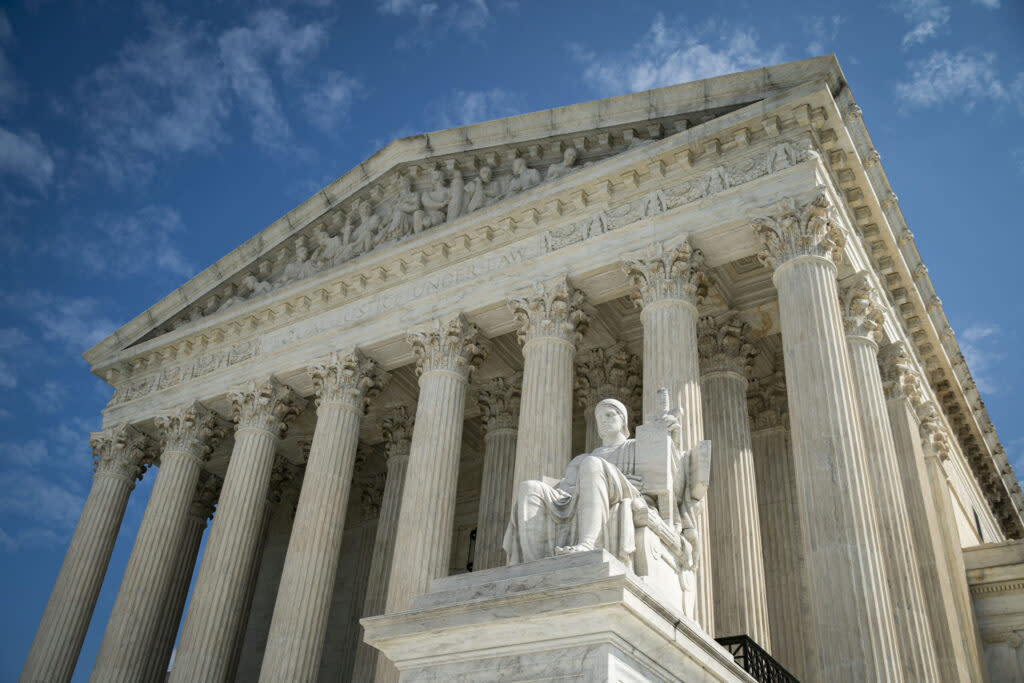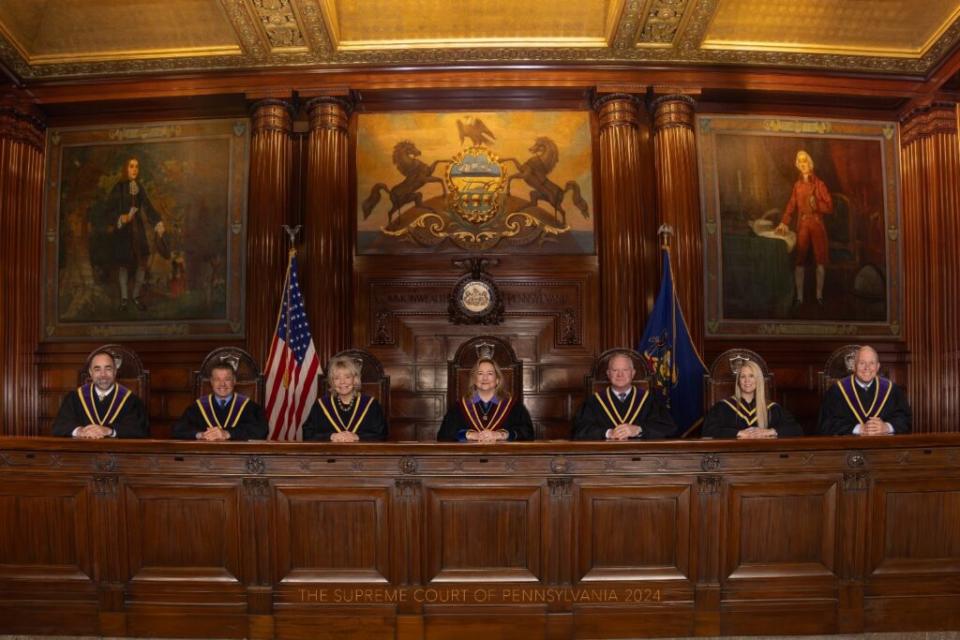Pennsylvania’s Supreme Court does not align with ideological split of SCOTUS Chevron decision

- Oops!Something went wrong.Please try again later.
The U.S. Supreme Court. (Al Drago/Getty Images)
Recently, the U.S. Supreme Court, in Loper Bright Enterprises v. Raimondo and Relentless, Inc. v. Department of Commerce (together, Loper Bright) overturned what is colloquially known as the “Chevron doctrine.” The doctrine is a judge-made, legal principle adopted by the U.S. Supreme Court 40 years ago that required federal courts to give deference to federal agencies’ interpretations of ambiguous statutes and regulations passed by Congress.
The idea behind the doctrine was that federal agencies were run by subject-matter experts who were better equipped to administer, enforce and, importantly, interpret Congress’s statutes, rather than unelected federal judges who had little, if any, expertise or understanding of the nuances and intricacies of the complex problems—or scientific terminologies—agencies sought address.
But the recent commentary from some of the nation’s prominent legal analysts and pundits, from Ruth Marcus at The Washington Post to Adam Liptak at The New York Times, are overly simplistic and somewhat misleading takes on the broader ideological breakdown in support of or in opposition to Chevron. The commentary suggests there are fixed ideological camps on each side of the Chevron national debate—Republican and conservative-leaning jurists are anti-Chevron deference, while Democrat and liberal-leaning jurists are pro-Chevron deference.
The Chevron question is, like many constitutional and administrative law issues, far more nuanced than how national commentators and pundits may lead us to believe. While those opposed to federal court deference to federal agencies have trended more conservative over the last 20 years, “states where courts have employed a deferential standard towards [state] agency expertise have diverse ideological and political majorities.”
The Pennsylvania Supreme Court is one example where the traditional ideological and political tents do not parallel the U.S. Supreme Court’s majority and dissenting opinions in Loper Bright. The state high court “has never expressly adopted the federal Chevron approach,” but the court has also conceded that the federal Chevron version “is indistinguishable from [Pennsylvania’s] own approach to agency interpretations of [Pennsylvania] statutes.” Part of the reason for the lack of alignment, in theory and practice, is that the Chevron doctrine was applicable primarily to federal courts and federal agencies. State courts and state agencies, such the Commonwealth Court or the Department of Environmental Protection, have always had the independence to diverge from or converge with the Chevron doctrine as a matter of state constitutional and state administrative law.
It’s fair to say that the doctrine employed by the Pennsylvania Supreme Court to review state agency decisions is “rooted in federal precedents” and “closely grounded upon earlier federal cases.” However, even in light of the state Supreme Court’s historic following of Chevron-like deference of its own volition, the Justices diverge in their positions on the doctrine in ideologically and partisan ways that are not aligned with traditional camps at the federal level.
In 2019, Justice Christine Donohue, an elected Democrat and liberal-leaning jurist, who believes the state constitution’s Equal Rights Amendment includes a right to abortion, said, in a concurring opinion in Harmon v. Unemployment Compensation Board Review, “I write separately to state my disagreement with the Majority’s discussion of administrative deference.” She explained, “In my view, while an administrative agency’s interpretation of a statute is one of many factors that a court may consider when interpreting an ambiguous statute, it is not entitled to any deference in the interpretative process.”
She concluded that her position was “consistent with the fundamental precept that the interpretation of statutes is a question of law for reviewing courts to decide…[a]dministrative agencies, unlike courts, have no particular expertise in interpreting statutes, and I reject any rule of construction that would require courts to abdicate our judicial role to administrative agencies…” One could easily mistake her writing for that of Republican-appointed, center-right Chief Justice John Roberts opinion in his Loper Bright ruling overturning Chevron, where he explained courts “decide legal questions by applying their own judgment” and federal agencies’ interpretations of statutes “are not entitled to deference.”
Justice David Wecht is another Democrat and liberal-leaning jurist on the state high court who, like Justice Donohue, believes Pennsylvania’s Constitution enshrines a right to abortion. He wrote a concurrence offering a similar anti-Chevron position. He noted, “As I have explained in the past, I do not agree that reviewing courts should afford what often amounts to unqualified deference—i.e., Chevron deference—to an executive-branch agency’s interpretation of an ambiguous statute.”
If a law is unclear, he wrote in Snyder Bros., Inc. v. Pa. Pub. Util. Comm’n, “we must perform our interpretive duty.” Justice Wecht’s position neatly aligns with Chief Justice Roberts’s majority opinion in Loper Bright, but it also echoes Justice Clarence Thomas’s concurring opinion in support of overruling Chevron. Justice Thomas explained that Chevron “must finally be overruled” and that the doctrine incorrectly required jurists to defer to an agency’s interpretation of an ambiguous statute and thus stripped judges of their constitutional duties to interpret statutory provisions when reviewing federal statutes as applied to agency actions.
The late-Chief Justice Max Baer, a Democrat-elected jurist—who played a key role in liberally construing the state constitution’s Free and Equal Elections Clause to expand the right to vote by extending the date to submit mail-in ballots in the lead up to the 2020 Presidential Election amid the unprecedented pandemic—was quite lukewarm towards Chevron. In 2007, he wrote, “While I agree that the Secretary [of Education] enjoys a great deal of latitude in administering the [Education Empowerment Act], I do not believe that … administrative interpretations forwarded for the first time in connection with adversarial litigation, are entitled to any more weight than any other litigant’s argument[.]”
He proceeded to recognize how the U.S. Supreme Court’s Chevron views were, at the time, beginning to evolve and recognize the “dangers of deferring to [agency] interpretations developed” amid litigation.
Like Justices Wecht and Donohue, Baer’s position on Chevron writes more like Justice Neil Gorsuch, a Trump-appointed conservative jurist, who argued in his concurring opinion in Loper Bright that the weight of agency interpretations cannot outweigh the long-settled principle that courts must independently exercise their judgment in reviewing statutes and regulations, instead of deferring to those interpretations, whether at the litigation or rulemaking stages, from purported agency expertise.
Indeed, compare the state Democratic-liberal Justices’ takes on Chevron with their state Republican-conservative counterparts.
The former Chief Justice Thomas Saylor of the Pennsylvania Supreme Court, a conservative Republican, was a vocal defender of Chevron-like deference. He believed that “some consideration” should be afforded to the role of state agencies interpretation of statutes. Relying on U.S. Supreme Court precedent, Justice Saylor noted that “deference is due to the [agency]” and that it is well settled that “[a]n interpretation by the agency charged with the administration of a particular law is normally accorded deference, unless clearly erroneous.”
Justice Sallie Updyke Mundy, a Republican Justice, favored Chevron-like deference and agreed with former Chief Justice Saylor’s take on Chevron. She wrote, in her Harmon dissent, that it is “well[-]settled” law that an agency’s interpretation of a statute or regulation, when administering a particular law, “is normally accorded deference” and that the court should “grant deference” in the case before it.
These conservative-Republican state jurists’ views parallel the Loper Bright dissenting opinion penned by Justice Elena Kagan and joined by Justices Sonia Sotomayor and Ketanji Brown Jackson, known as the liberal wing of the U.S. Supreme Court. In determining who decides what the ambiguous words enacted by Congress mean, Justice Kagan argued that “the choice should usually fall to agencies, with courts broadly deferring to [the agencies’] judgments.”
The point is not to recast Justices Wecht, Donohue and Baer as closet Republican-conservative Justices like Justices Roberts, Thomas and Gorsuch, nor is this meant to paint Justices Mundy and Saylor as liberal stalwarts of the ilk of Justices Kagan, Sotomayor and Jackson. Far from it.
Instead, we should be careful not to cast ideological generalizations about all major U.S. Supreme Court decisions as indicative of the broader views and positions of other American legal institutions. The ideological and partisan make-up of state courts do not always share or align with the ideological breakdown of each and every U.S. Supreme Court decision, nor should they. The overruling of Chevron is a stark reminder of that reality
The post Pennsylvania’s Supreme Court does not align with ideological split of SCOTUS Chevron decision appeared first on Pennsylvania Capital-Star.


